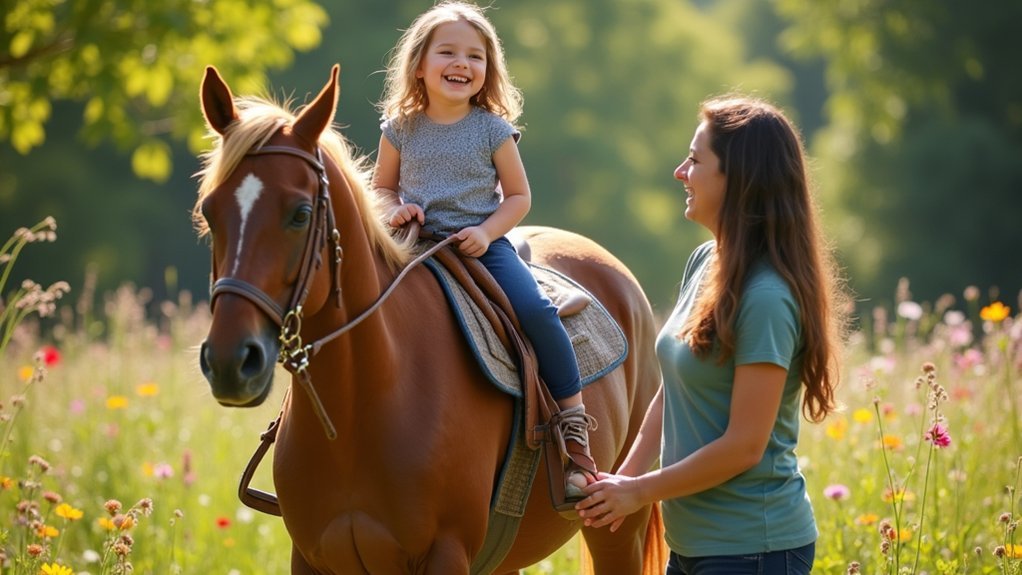Equine therapy transforms cerebral palsy treatment through the horse’s rhythmic movement, promoting neuroplasticity and improved motor function. You’ll find two main approaches: hippotherapy (medical treatment) and therapeutic riding (recreational skills). The therapy builds physical strength, reduces spasticity, enhances emotional well-being, and improves cognitive skills like attention and decision-making. With documented improvements of up to 22% in motor skills, this unique intervention offers hope beyond traditional treatments.
What Is Equine Therapy and How Does It Work for Cerebral Palsy?

While many therapeutic approaches exist for cerebral palsy, equine therapy stands out as a unique intervention that harnesses the natural movement of horses to facilitate healing. This therapy comes in two main forms: hippotherapy, which focuses on physical benefits from the horse’s movement, and therapeutic riding, which emphasizes riding skills for broader development.
When you’re participating in equine therapy, you’re experiencing an all-encompassing approach that combines physical, occupational, and psychological techniques. The horse’s movement helps improve your balance, strength, and posture—critical areas affected by cerebral palsy. Hippotherapy sessions are carefully designed to build strength and endurance through responses to the horse’s natural gait.
You’ll notice enhancements in gross motor function as the rhythmic movement of the horse stimulates your muscles and nervous system. Plus, the emotional connection you’ll form with these intuitive animals boosts self-esteem and helps with emotional regulation.
The Science Behind Horse Movement and Motor Function Improvement
The rhythmic, three-dimensional movement of a horse creates a unique pattern that your child’s body naturally responds to, improving core strength and balance.
This repeated motion stimulates neuroplasticity in the brain, allowing new neural pathways to form that support better motor function development.
Your child’s body will gradually synchronize with the horse’s movement, creating a therapeutic experience that can’t be replicated in traditional physical therapy settings. The eight EAAT sessions over three weeks combine horse handling activities like touching and grooming, with structured riding exercises focused on posture and navigating obstacles.
Rhythmic Movement Benefits
Understanding how a horse’s rhythmic movement impacts motor function requires looking at the underlying neurophysiological processes at work. When you sit atop a horse, its consistent, rhythmic gait activates neuroplasticity in your brain, allowing for reorganization of motor pathways.
This natural rhythm provides powerful sensory input that helps reduce spasticity while enhancing brain-muscle coordination. You’ll notice improvements in core strength and stability as your body responds to the horse’s movement patterns.
These rhythmic motions also aid in integrating primitive reflexes, particularly beneficial for children with spastic cerebral palsy. Dr. Harald Blomberg’s work demonstrates how these targeted movements help reduce tension patterns and improve postural stability.
Beyond physical benefits, the rhythmic experience of horseback riding improves cardiorespiratory fitness and emotional well-being. The combination of rhythmic stimulation with sensory integration creates an ideal environment for motor pattern development, ultimately leading to better balance, gait, and overall functional movement.
Neuroplasticity Through Riding
Neuroplasticity—the brain’s remarkable ability to form new neural connections—forms the scientific foundation for equine therapy’s effectiveness in cerebral palsy treatment. When you’re on horseback, your brain receives diverse sensory inputs that actively reshape neural pathways responsible for motor function. Strong evidence demonstrates that hippotherapy provides significant improvements in both overall gross motor function and specific walking capabilities.
| Brain Mechanism | Equine Therapy Benefit |
|---|---|
| Motor Cortex Adaptation | Improved gross motor skills measured by GMFM-88 |
| Sensory Integration | Enhanced walking capabilities and functional mobility |
| Neural Pathway Formation | Reduced spasticity and improved muscle tone |
| Repetitive Movement Learning | Long-term motor function adjustments |
Research consistently demonstrates that the three-dimensional movement of horses provides repetitive stimuli that your brain integrates into improved physical function. These adaptations aren’t temporary—studies show sustained improvements over months, complementing traditional physical therapy approaches while offering unique neurological benefits conventional treatments alone can’t provide.
Horse-Human Movement Synchronization
At the heart of equine therapy’s neurological benefits lies a fascinating phenomenon: the synchronization between horse and human movements. When you walk alongside or ride a horse, your physiological systems begin to align, creating a powerful therapeutic effect for cerebral palsy.
This synchronization works through:
- Rhythmic entrainment – Your body naturally adjusts to match the horse’s three-dimensional movement, reinforcing neural pathways essential for coordination.
- Multi-sensory integration – Your brain processes vestibular, tactile, and proprioceptive inputs simultaneously.
- Heart rate coupling – Your cardiovascular system synchronizes with the horse, potentially creating an ideal state for motor learning. Research by Dr. Ann Baldwin shows that this heart rate connection becomes most coherent when individuals express positive feelings or simply sit quietly with the horses.
- Focused attention – The concentration required enhances your motor planning abilities while the horse’s movement provides consistent sensory input that helps normalize muscle tone.
Physical Benefits: Building Core Strength and Balance Through Riding
Physical improvements in children with cerebral palsy form one of the most significant benefits of equine therapy, with core strength development standing at the forefront.
When your child sits on a horse, they’re constantly making micro-adjustments to maintain balance, which strengthens their trunk muscles and improves posture.
The horse’s three-dimensional movement mimics human walking patterns, helping your child’s body learn proper movement sequences while reducing abnormal muscle tone.
This dynamic interaction enhances postural symmetry, particularly in the trunk and hips, leading to better control of extremities.
Research supports these benefits with Level 2a evidence showing improved muscle symmetry.
A 2009 study demonstrated significant improvement in head and trunk control after just 12 weeks of equine therapy sessions.
You’ll likely notice better gross motor function that persists even after therapy ends, as these physical gains translate into meaningful improvements in daily activities.
Cognitive Development Through Horse-Human Connection

Beyond the physical benefits, the cognitive development fostered through horse-human connection represents a powerful dimension of equine therapy for children with cerebral palsy.
You’ll notice remarkable improvements in your child’s attention span and focus during their 16-week therapy journey, especially if they also have ADHD.
The multisensory environment creates cognitive growth through:
The rich, multisensory world of equine therapy creates neurological connections that spark remarkable cognitive development in children with cerebral palsy.
- Enhanced attention capabilities – Children concentrate longer during therapy sessions, improving participation in daily activities.
- Social skill development – Nonverbal connections with horses bridge communication gaps and reduce isolation.
- Multisensory stimulation – Combined tactile, vestibular, and proprioceptive inputs promote neuroplasticity.
- Executive function improvement – Decision-making, planning, and problem-solving skills develop through structured equine activities.
Regular hippotherapy sessions contribute to significant improvement in speech and memory functions, which are crucial aspects of long-term benefits for individuals with cerebral palsy.
Emotional Well-Being and Self-Confidence Gains From Equine Therapy
The gentle strength of a horse becomes your mirror, reflecting back the accomplishments you’ve made during each therapy session.
You’ll discover connections that transcend verbal communication, creating bonds that boost emotional resilience regardless of physical limitations.
Your confidence grows with each interaction, as the partnership with these majestic animals helps you tap into reserves of courage you mightn’t have known existed.
This non-judgmental environment provides individuals with cerebral palsy a unique space for emotional exploration and self-expression that traditional therapy settings might not offer.
Self-Esteem Through Achievement
Achievement stands as a powerful catalyst for self-esteem development in children with cerebral palsy participating in equine therapy. When your child completes riding tasks or successfully manages a horse’s movement, they experience genuine accomplishment that translates to other areas of life.
The typical 10-week hippotherapy program creates consistent opportunities for your child to build self-worth through:
- Weekly progression of skills that establishes measurable improvements
- Structured goal-setting that reinforces positive self-perception
- Mastery experiences that counter feelings of limitation
- Fun, novel environments that make therapeutic gains enjoyable
As your child accumulates these victories in the saddle, they’re not just learning to ride—they’re discovering their own capabilities, developing confidence that extends beyond the stable into everyday challenges.
Bonding Beyond Barriers
Forming emotional connections presents unique challenges for many children with cerebral palsy, yet equine therapy offers a remarkable pathway to emotional growth and self-assurance.
When your child interacts with these gentle animals, they’ll experience the calming effects of rhythmic movement that naturally reduces anxiety and stress responses.
Horses provide non-judgmental companionship, creating a safe space for emotional vulnerability and expression that might otherwise remain hidden.
You’ll notice how these equine relationships foster trust and reduce isolation. The therapeutic environment encourages your child to develop healthier coping strategies through nonverbal communication with their horse partners.
This emotional regulation extends beyond the stable, improving social relationships and overall psychological well-being.
The enjoyable nature of equine therapy makes children view it as a positive reinforcement rather than traditional therapy work, significantly enhancing their motivation to participate.
The bond formed with horses transcends physical limitations, opening doors to emotional healing previously thought impossible.
Finding Inner Strength
Beyond the physical benefits, equine therapy offers a powerful journey toward emotional resilience and self-confidence for children with cerebral palsy.
You’ll notice your child developing inner strength as they connect with these gentle animals in a therapeutic setting.
The emotional transformation includes:
- Enhanced emotional regulation – your child learns to manage feelings more effectively through structured interactions with horses.
- Boosted self-confidence – accomplishing riding skills creates pride and independence.
- Improved coping strategies – horses provide a unique environment for developing stress management techniques.
- Greater emotional stability – the rhythmic movement of horses has a calming effect that soothes anxiety.
This emotional growth complements physical progress, creating a holistic approach to therapy that addresses both body and mind simultaneously.
Comparing Hippotherapy and Therapeutic Horseback Riding Approaches
While both involve horses and benefit individuals with cerebral palsy, hippotherapy and therapeutic horseback riding represent two distinct approaches with different goals and methodologies.
Hippotherapy is medical treatment provided one-on-one by licensed therapists who use the horse’s movement to improve your neurological functioning, balance, and mobility. Sessions target specific therapeutic outcomes with measurable goals and are often covered by insurance.
Hippotherapy harnesses the horse’s natural movement as medicine, delivering targeted therapy with measurable outcomes under professional care.
In contrast, therapeutic riding focuses on teaching you adaptive horseback riding skills in group settings. Led by certified riding instructors with volunteers, these sessions emphasize recreational enjoyment, confidence-building, and socialization rather than clinical outcomes.
Your needs will determine which approach is best—hippotherapy for targeted physical therapy and functional improvements, or therapeutic riding for recreational skill development and social benefits. Hippotherapy requires a doctor’s prescription as it is considered a legitimate medical intervention strategy rather than purely recreational activity.
Measuring Progress: Assessment Tools for Equine Therapy Outcomes

How do we perceive if equine therapy is truly making a difference for cerebral palsy patients? Clinicians rely on specialized assessment tools to track improvements across key functional areas.
When your child participates in equine therapy, progress is typically measured using:
- Gross Motor Function Measure (GMFM-88) – Evaluates changes in gross motor function with statistical significance (p < 0.005) and shows improvements that last up to two months post-therapy.
- Modified Ashworth Scale (MAS) – Assesses muscle spasticity, though results show variable statistical significance.
- Quality of Life Assessments – Measure overall wellbeing, though improvements are often noted in specific domains rather than global scores.
- Walking Capability Tests – Document enhanced motor skills compared to standard care approaches.
The hip adductor Ashworth scale has shown a significant 22% improvement in spasticity after just 5 weeks of horseback riding therapy when combined with conventional rehabilitation methods.
Real Stories: Children With CP Experiencing Transformation
The transformative power of equine therapy reveals itself most vividly through individual success stories. Numerous studies document significant improvements in motor control and balance after children with cerebral palsy participate in equine therapy sessions.
You’ll find parents consistently reporting noticeable enhancements in their children’s confidence and physical abilities. These aren’t just anecdotal claims—clinicians confirm that the horse’s natural gait simulates human walking motions, providing unique benefits that traditional therapies can’t replicate. Recent research demonstrates that these improvements in gross motor function can be maintained for up to two months after the therapy ends.
Children themselves express increased enjoyment during these sessions, often engaging more enthusiastically than in conventional rehabilitation settings.
Beyond physical improvements, these programs create supportive communities where families connect with others facing similar challenges, fostering a sense of belonging and shared progress.
Finding the Right Equine Therapy Program for Your Child

Selecting an appropriate equine therapy program for your child with cerebral palsy requires careful consideration of multiple factors that can greatly impact treatment outcomes.
When evaluating potential programs, focus on these essential elements:
- Therapist Credentials: Confirm therapists have specialized training in equine-assisted therapies and appropriate certification for working with children who’ve cerebral palsy.
- Program Accreditation: Look for facilities accredited by organizations like PATH, which maintains high standards for safety and effectiveness.
- Personalized Approach: The program should offer individualized treatment plans with regular progress assessments tailored to your child’s specific needs.
- Facility Accessibility: Verify the location has wheelchair-accessible pathways, appropriate adaptive equipment, and possibly transportation assistance if needed.
Don’t hesitate to request testimonials from other families or schedule facility visits before making your decision. Many quality programs offer three-dimensional movement experiences that help children develop better balance and posture while providing crucial physical therapy benefits.
Cost Considerations and Insurance Coverage for Equine Therapy
You’ll face significant hurdles with insurance reimbursement for equine therapy, as many providers classify it as experimental despite its benefits for cerebral palsy.
Various funding assistance programs, including nonprofit scholarships, TRICARE’s ECHO program, and state disability waivers, can help offset the substantial out-of-pocket costs.
When weighing the investment, consider both the direct expenses and the potential physical, emotional, and social gains that might reduce other medical interventions over time. The limited scientific documentation on therapeutic riding benefits continues to be a major obstacle for securing consistent insurance coverage despite positive clinical observations.
Insurance Reimbursement Challenges
Despite mounting evidence supporting its therapeutic benefits, equine therapy faces significant insurance reimbursement hurdles that limit access for many families affected by cerebral palsy.
While European countries like Germany and Sweden include hippotherapy in their national health coverage, U.S. insurers like Aetna don’t guarantee coverage as standard treatment.
If you’re seeking equine therapy, you’ll encounter these major obstacles:
- Most U.S. insurance plans classify hippotherapy as “experimental,” requiring out-of-pocket payment.
- Coverage policies vary dramatically by location and specific insurance provider.
- Low-income families face disproportionate access barriers without reimbursement options.
- Advocacy efforts for policy change progress slowly despite documented benefits.
This reimbursement gap creates substantial financial burdens, with costs typically falling to families or charitable organizations rather than healthcare systems.
Funding Assistance Programs
Families maneuvering the financial challenges of equine therapy have several funding lifelines available despite limited insurance coverage.
With sessions averaging $60 each and full 8-week programs costing around $480, costs can quickly accumulate without assistance.
Fortunately, grants from organizations like the M.J. Murdock Charitable Trust help expand accessibility through scholarship programs and equipment funding.
You’ll find that many equine centers offer sliding scale fees and multi-session discounts to ease financial burden.
Look into community-based fundraising options like charity events, crowdfunding campaigns, and corporate partnerships that support therapeutic riding centers.
These alternative funding sources often cover critical expenses like specialized equipment and therapeutic materials.
Many non-profits such as Victory Ranch also facilitate donations of horses and supplies, further reducing operational costs that would otherwise be passed to participants.
Horse therapy provides physical benefits including improved muscle strength, balance, coordination, and flexibility for individuals with cerebral palsy.
Cost-Benefit Analysis
When weighing the financial investment against therapeutic outcomes, equine therapy presents a complex cost-benefit scenario for families managing cerebral palsy. Sessions typically range from $50-$300, with frequency and duration notably impacting overall costs.
While insurance coverage remains limited, you can improve your chances of reimbursement by:
- Obtaining a doctor’s prescription documenting medical necessity
- Checking if your private insurance covers alternative therapies
- Investigating your state’s Medicaid provisions for equine therapy
- Researching if your employer’s health plan offers flexible spending options
The documented improvements in gross motor function, confidence, and social skills often justify the expense for many families, especially considering the potential long-term benefits that extend beyond the therapy sessions themselves. Finding a local equine therapist through professional therapist directories can help families connect with practitioners who offer sliding-scale fees or scholarship programs.
Preparing for Your First Equine Therapy Session
How can you best prepare for your first equine therapy session? Begin by understanding that hippotherapy requires qualified therapists who’ll guide the horse to improve your child’s motor functions and gait patterns.
You’ll need an extensive assessment to guarantee your child’s safety and suitability for the program.
Expect a stable environment designed for varying physical abilities, with safety equipment and continuous supervision.
Sessions are structured around your child’s unique needs, with the horse’s rhythmic movement mimicking natural walking patterns to reduce spasticity and enhance neuromuscular integration.
Family involvement is essential—you’ll play a supportive role in reinforcing outcomes.
Remember, equine therapy supplements traditional treatments for cerebral palsy, which affects 2-3 per 1,000 births globally.
Familiarizing your child with horses beforehand can greatly enhance their therapeutic experience.
Complementary Therapies That Enhance Equine Therapy Benefits

While preparing for your first equine therapy session sets the foundation, combining hippotherapy with other therapeutic approaches can maximize your child’s progress.
An integrated rehabilitation plan creates a thorough treatment strategy that addresses multiple aspects of cerebral palsy simultaneously.
A multi-faceted treatment approach tackles cerebral palsy’s challenges from every angle for comprehensive healing.
For ideal results, consider these complementary therapies:
- Traditional physical therapy – Reinforces motor skills developed during hippotherapy sessions and provides targeted exercises.
- Occupational therapy – Improves daily living skills while building upon equine-developed coordination.
- Speech therapy – Leverages the emotional connection with horses to encourage communication development.
- Sensory integration therapy – Works synergistically with the sensory stimulation naturally provided during horseback riding.
Hippotherapy engages multiple body systems through the unique movement patterns that simulate human ambulation.
Discuss these options with your healthcare team to create a customized approach that amplifies the neuromotor stimulation and physical benefits your child receives from equine therapy.
Long-term Outcomes: Sustaining Improvements Beyond the Stable
The benefits of equine therapy extend far beyond the immediate riding session for children with cerebral palsy. Consistent hippotherapy shows promising results for improving walking ability and motor function over year-long programs.
You’ll notice that regular sessions are essential for maintaining these gains.
While motor improvements are well-documented, quality of life enhancements vary between individuals. Your child’s specific CP severity, therapy intensity, and treatment duration all influence outcomes.
Combining hippotherapy with other therapies often produces better long-term results.
Measuring success typically involves standardized tools like the GMFCS and GMFM, though research still faces methodological challenges.
For sustained benefits, you’ll need to take into account both the physical therapy aspects and the supportive environment you create at home between sessions.
Frequently Asked Questions
At What Age Can Children With CP Start Equine Therapy?
You can start your child with CP on equine therapy at almost any age. While most studies focus on children aged 4-10, there’s no specific age limit as it’s adaptable to individual needs.
Are There Specific CP Types That Benefit More From Equine Therapy?
Children with spastic diplegic and hemiplegic CP benefit most from equine therapy due to improvements in balance and symmetrical muscle use. You’ll also see benefits in mixed and dyskinetic CP types through enhanced trunk stability.
What Safety Precautions Are Taken During Equine Therapy Sessions?
You’ll find numerous safety measures during sessions including therapist supervision, proper helmets and gait belts, specially selected horses, trained handlers, emergency protocols, and continuous monitoring to keep you secure throughout your experience.
How Are Therapy Horses Selected and Trained?
You’ll find therapy horses are selected for their calm temperament and smooth gait patterns. They’re trained to follow handler instructions, remain neutral to distractions, and accept gentle handling from therapists and side-walkers.
Can Adults With Cerebral Palsy Benefit From Equine Therapy?
Yes, you’ll gain multiple benefits from equine therapy including improved motor skills, better balance, reduced muscle spasticity, enhanced core strength, increased confidence, and social connections—all especially valuable for adults with cerebral palsy.
In Summary
You’ve discovered equine therapy’s power for cerebral palsy. Whether you’re seeking physical strength, cognitive growth, or emotional confidence, horses provide unique benefits that complement traditional treatments. Don’t let cost concerns stop you—explore insurance options and start with realistic expectations. With consistent sessions and complementary therapies, you’ll likely experience improvements that extend far beyond the stable, transforming your daily life in meaningful ways.





Leave a Reply